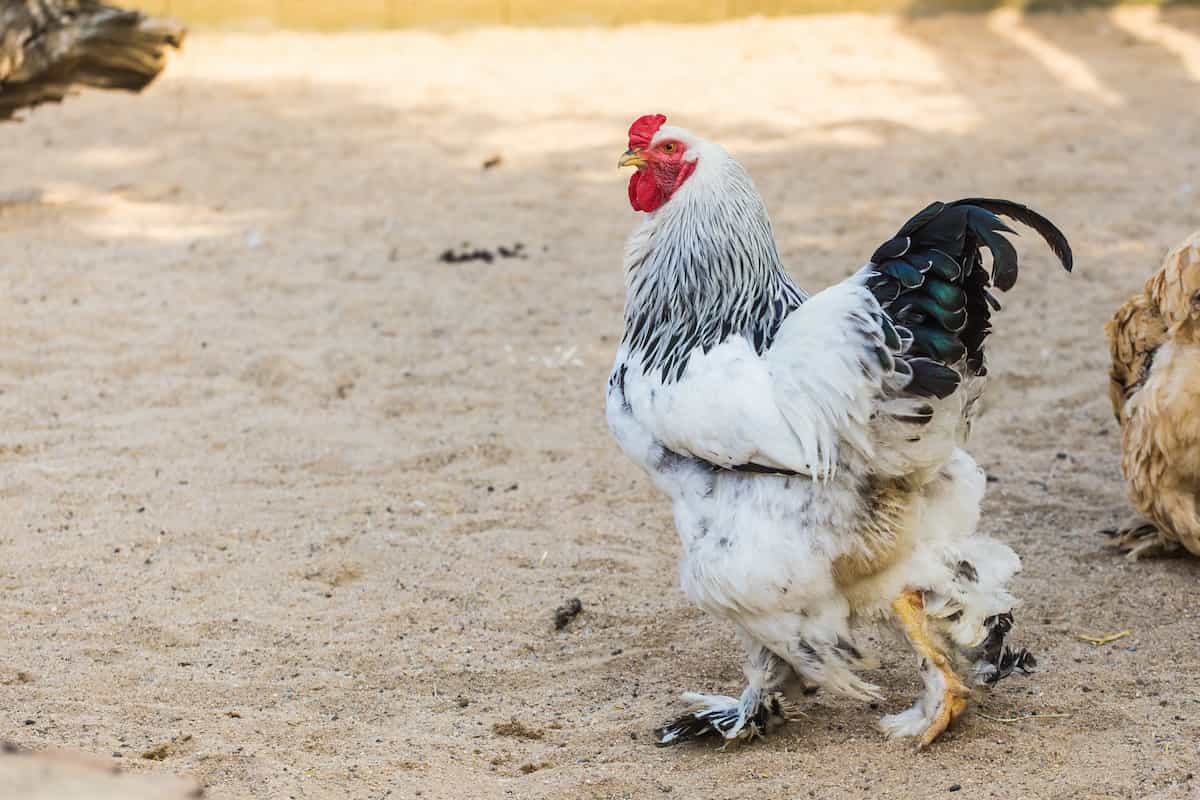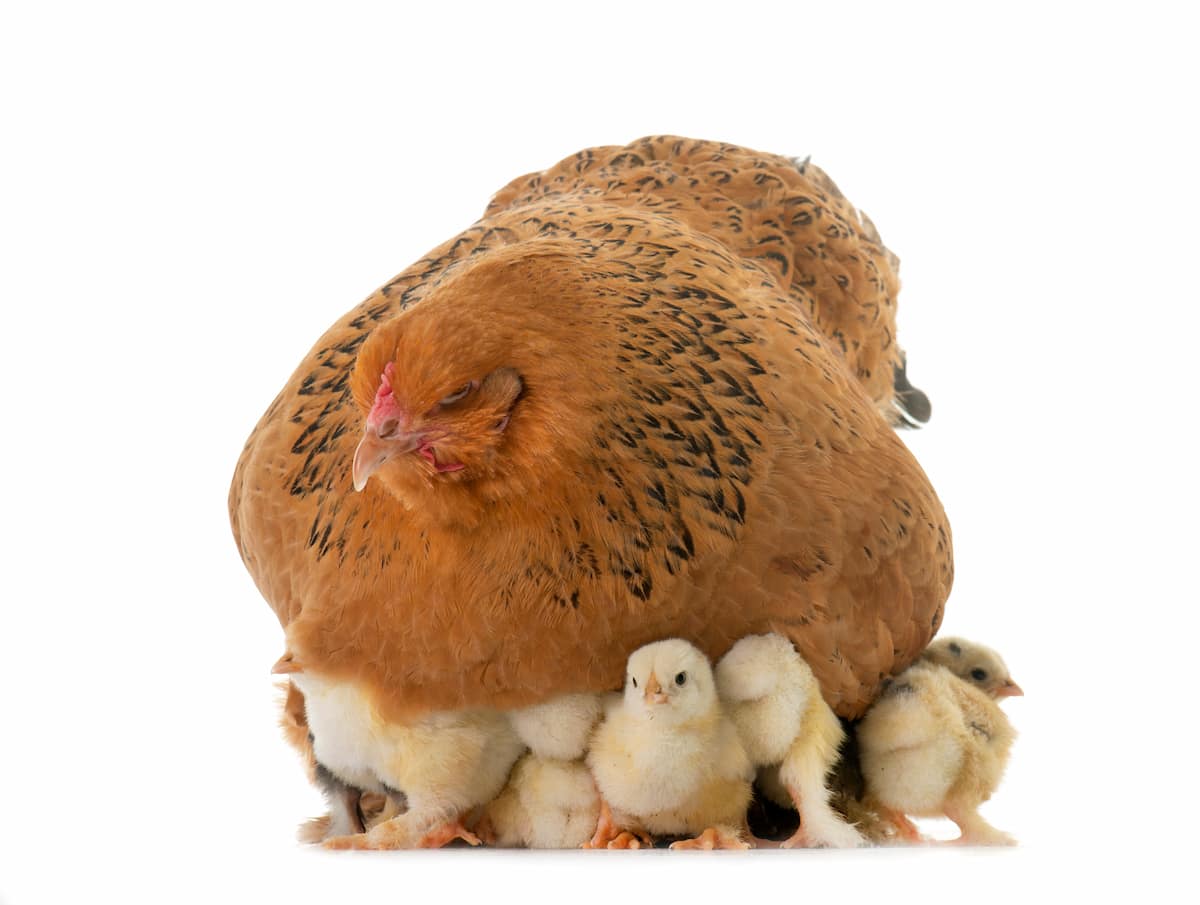The Brahma chicken is known for its docile nature and hardiness and is a popular breed for egg and meat production. The Brahma chicken is sometimes called the “King of All Fowls” due to its large size and regal appearance. Brahma chickens are a large breed known for being calm and docile. They are a good choice for backyard chicken keepers who want a low-maintenance pet chicken.

Guide to Brahma Chicken Breed
Physical Characteristics of the Brahma Chicken Breed
- Size – 30 inches tall with males weighing 12 pounds, females weighing 10 pounds
- Purpose – Multi-purpose chicken breed
- Lifespan – 5–8 years
- Egg Production – 150 to 300 eggs per year
- Cost to purchase – $3-$10/bird
They are a hardy breed, with feathers that protect them from cold and heat. Brahma chickens are available in various colors, including light, dark, buff, and partridge. They are also very good-natured, making them perfect for families with children. With the right care and consideration, they can be long-lived birds with plenty of time for egg production. Brahma chickens do well in free-range and backyard environments. Brahma chickens are also known for being good egg layers, producing around 150 to 300 eggs per year.
What are the Benefits of Keeping Brahma Chickens?
- They are one of the most docile chicken breeds.
- They are also relatively easy to care for and require less maintenance than other chicken breeds.
- Brahma chickens are known to lay large eggs and, therefore, a good choice for those looking to increase their egg production.
The Best Ways to Raise Brahma Chickens
- Provide plenty of space – Brahma chickens need more space than other chicken breeds because of their size. They should have at least 10 square feet per chicken in their coop and even more space in their outdoor run.
- Keep them well-fed and watered – Like all chickens, Brahma chickens need a diet of quality chicken feed, fresh water, and occasional treats like scratch grain or mealworms. Make sure their food and water dishes are clean and filled daily. Feed your Brahma chickens a high-quality diet with protein to help them grow strong and healthy.
- Keep an eye on their health – Check your Brahma chickens regularly for signs of illness, such as lethargy, reduced appetite, or unusual behavior. If you notice any changes in their health, consult a veterinarian immediately. Keep an eye on your Brahma chickens during hot weather, as they can be prone to heat stroke. Ensure they can access plenty of water and shade in their coop and run.
- Give them plenty of attention – Although they are not as high-maintenance as some other chicken breeds, Brahma chickens still enjoy being around people and being petted or scratched occasionally. Spending time with your chickens daily to bond and keep them happy and healthy.
Enclosure/Cage Requirement to Raise Brahma Chickens
Brahma chickens are a large, docile breed well suited for life in an enclosure or cage. They are not particularly active birds and do not require a lot of space to live happily. A minimum-sized enclosure for two Brahma chickens should be 10 square feet. A larger cage will allow your chickens to move around more and stay healthy if you have the room.
The best type of enclosure for Brahma chickens is one that has both an indoor and outdoor area. The indoor area should have plenty of space for the birds to roost and nest, while the outdoor area should have room to stretch their legs and explore. If you live in an area with cold winters, ensuring your Brahma chicken’s enclosure has enough ventilation to prevent the birds from getting too cold is important.
In case you missed it: The Ultimate Guide to Silkie Chicken Breed

Lighting Requirement for Brahma Chickens
When lighting your Brahma chickens, you must provide them with 14-16 hours of light per day during winter. This can be achieved using a light bulb in their coop or natural sunlight. During the summer, they will need less light, around 10-12 hours daily.
Best Feed for Brahma Chickens
For a Brahma chicken to maintain optimal health and weight, they need a high-protein diet. The best way to give your Brahma chicken a high-protein diet is by feeding them a commercial layer feed with at least 16% protein. You can supplement your diet with cooked meats, such as chicken or beef, and cooked beans and legumes.
In addition to a high-protein diet, Brahma chickens also need plenty of fresh water. Always provide them with clean water and change it out daily. Giving them access to grit is also important, which helps them grind up their food in their gizzards. You can offer them grit in a small dish or add it to their food.
Create a Suitable Coop for Raising Brahma Chicken Breed
If you raise Brahmas for egg production, you must provide them with a suitable coop. The coop should be large enough to comfortably accommodate the number of chickens you have, with plenty of space for them to move around and stretch their wings. It should also have perches and nesting boxes for the chickens to use. The coop should be well-ventilated to help keep the chickens healthy and protected from predators.
What are Some Common Health Problems in Brahma Chickens?
Brahma chickens are susceptible to a few health problems despite their generally good health. One common health problem is Newcastle disease, a viral respiratory disease that can be deadly in poultry. Another common health problem is Marek’s disease, a virus that affects the nervous system and can cause paralysis.
Tips for Keeping Your Brahma Chicken Healthy
- When it comes to keeping your Brahma chicken healthy, there are a few key things to remember. First and foremost, Brahma chickens are particularly susceptible to Marek’s Disease, so it’s important to get them vaccinated against it.
- As far as diet goes, Brahma chickens do best on a diet that consists mostly of grains and greens. They also need access to plenty of fresh water at all times. If you’re unsure what kind of diet your Brahma chicken needs, talk to a vet or poultry specialist.
- Overall, Brahma chickens are relatively hardy birds. However, they require extra care and attention to stay healthy and happy.

Conclusion
The Brahma chickens are an excellent addition to any farm or homestead due to their hardiness, docile nature, and moderate egg production. From their impressive size and colorful feathers to their docile nature, Brahma chickens are a hardy breed that makes a great addition to any backyard flock.
- Ultimate Guide to Ossabaw Island Hog: Breeding, Raising, Diet, and Care
- Ultimate Guide to Juliana Pig: Raising Facts, Size, Diet, Care, and Lifespan
- Raising Lleyn Sheep: Disadvantages, Price, Uses, Characteristics, and Care
- Ultimate Guide to Meishan Pig: Breed Facts, Breeding, Raising, and Care
- Ultimate Guide to Teacup Pigs: Raising, Diet, Lifespan, Cost, and Care
- Guide to Raising Poll Dorset Sheep: Facts, Profile, Characteristics, Uses, and Care
- Ultimate Guide to Bighorn Sheep: Characteristics, Diet, Lifespan, Breeding, and Lifecycle
- Ultimate Guide to Raising Katahdin Sheep: Farming Facts, Breed Profile, Uses, and Care
- Ultimate Guide to Raising Oreo Cows: Belted Galloways Farming Facts, Profile, Uses, and Care